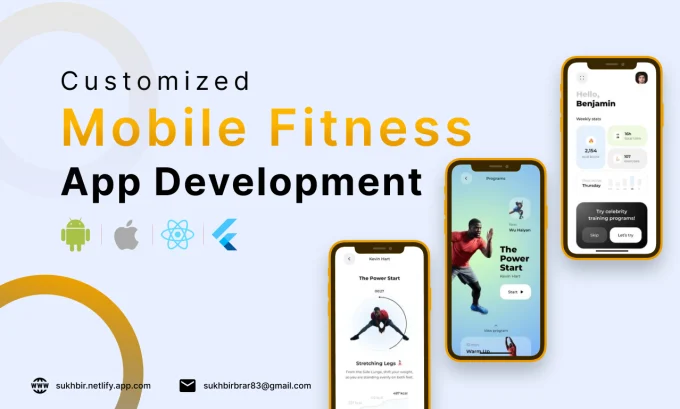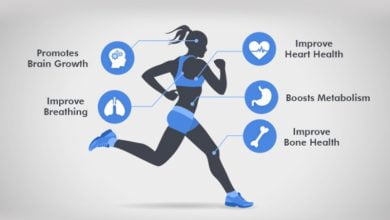Personalized Fitness App Development: Revolutionizing Health and Wellness

Introduction:
In today’s digital age, mobile technology has transformed nearly every aspect of our lives, including how we approach fitness and wellness. Personalized fitness apps have emerged as powerful tools that empower individuals to take control of their health and well-being, offering customized workout plans, nutrition tracking, progress monitoring, and expert guidance right at their fingertips. In this comprehensive guide, we’ll explore the growing trend of personalized fitness app development, discuss key features and considerations, and outline the steps involved in creating a successful fitness app tailored to individual needs and preferences.
The Rise of Personalized Fitness Apps:
The increasing prevalence of smartphones and wearable fitness devices has fueled the popularity of personalized fitness apps in recent years. These apps leverage cutting-edge technology, including artificial intelligence (AI), machine learning, and data analytics, to deliver tailored fitness experiences that cater to users’ unique goals, preferences, and fitness levels. By harnessing the power of data-driven insights and personalized recommendations, fitness apps empower individuals to achieve their health and fitness goals more effectively and efficiently than ever before.
Key Features of Personalized Fitness Apps:
Customized Workout Plans:
Personalized fitness apps offer tailored workout plans based on individual goals, fitness levels, and preferences. Users can choose from a variety of exercise modalities, such as strength training, cardio, yoga, and HIIT, and receive personalized recommendations to suit their needs.
Progress Tracking and Monitoring:
These apps allow users to track their progress over time, monitoring key metrics such as weight, body measurements, workout performance, and adherence to nutrition goals. Progress tracking provides valuable insights into users’ fitness journeys and helps them stay motivated and accountable.
Nutrition and Meal Planning:
Many personalized fitness apps include features for tracking nutrition intake, logging meals, and planning healthy menus. Users can set dietary preferences, track macronutrients and calories, and receive personalized meal recommendations and recipes to support their fitness goals.
Expert Guidance and Coaching:
Some fitness apps offer access to certified trainers, nutritionists, and health professionals who provide personalized guidance, coaching, and support. Users can receive feedback on their workouts, nutrition habits, and progress, helping them stay on track and make informed decisions about their health and fitness.
Community Support and Social Features:
Personalized fitness apps often include social features that allow users to connect with like-minded individuals, share achievements, and participate in challenges and competitions. Community support fosters motivation, accountability, and camaraderie among users, enhancing the overall fitness experience.
Integration with Wearable Devices:
Many personalized fitness apps integrate with wearable fitness devices, such as fitness trackers and smartwatches, to collect and analyze data on users’ activity levels, heart rate, sleep patterns, and more. Integration with wearable devices provides users with real-time feedback and insights, enhancing the accuracy and effectiveness of their fitness programs.
Considerations for Personalized Fitness App Development:
User Experience (UX) Design:
Designing a seamless and intuitive user experience is critical for the success of a personalized fitness app. Prioritize simplicity, ease of navigation, and visual appeal to ensure that users can easily access and engage with key features and content.
Data Privacy and Security:
Personalized fitness apps collect sensitive user data, including health information, activity levels, and dietary habits. Implement robust data privacy and security measures to protect user privacy and comply with regulatory requirements, such as GDPR and HIPAA.
Personalization Algorithms:
Develop advanced algorithms and machine learning models to analyze user data and provide personalized recommendations and insights. Leverage AI-driven insights to continuously refine and improve the app’s recommendations based on user feedback and behavior.
Scalability and Performance:
Ensure that the app is scalable and capable of handling a large user base and high volumes of data. Optimize performance and reliability to deliver a seamless experience across devices and platforms, minimizing downtime and latency.
Integration with Third-Party Services:
Integrate with third-party services and APIs, such as fitness equipment, nutrition databases, and health tracking platforms, to enhance the app’s functionality and interoperability. Seamless integration allows users to access a wide range of features and services within the app ecosystem.
Continuous Iteration and Improvement:
Embrace a culture of continuous iteration and improvement, gathering user feedback, analyzing usage metrics, and iterating on features and functionality based on insights. Regular updates and enhancements ensure that the app remains relevant, engaging, and effective in meeting users’ evolving needs.
Steps to Create a Successful Personalized Fitness App:
Market Research:
Conduct market research to identify target demographics, competitor offerings, and emerging trends in the personalized fitness app market. Identify gaps and opportunities for differentiation and innovation.
Define User Personas and Use Cases:
Develop detailed user personas and use cases to understand the needs, preferences, and pain points of target users. Use this information to inform the app’s design, features, and functionality.
Design Wireframes and Prototypes:
Create wireframes and prototypes to visualize the app’s user interface, navigation flow, and key features. Gather feedback from stakeholders and potential users to iterate on the design and improve usability.
Develop Backend Infrastructure:
Build the backend infrastructure to support user authentication, data storage, analytics, and integration with third-party services. Implement robust security measures to protect user data and ensure compliance with privacy regulations.
Frontend Development:
Develop the frontend of the app, including user interfaces, interactive elements, and visual design components. Prioritize responsiveness, accessibility, and intuitive navigation to deliver a seamless user experience across devices and platforms.
Implement Personalization Algorithms:
Develop and implement personalized recommendation algorithms based on user data, preferences, and goals. Leverage machine learning and AI techniques to analyze user behavior and provide tailored workout plans, nutrition recommendations, and coaching insights.
Integrate Third-Party Services:
Integrate with third-party services, APIs, and wearable devices to enhance the app’s functionality and interoperability. Ensure seamless data exchange and compatibility with popular fitness trackers, nutrition databases, and health monitoring platforms.
Testing and Quality Assurance:
Conduct rigorous testing and quality assurance to identify and address any bugs, glitches, or usability issues. Test the app across multiple devices, operating systems, and screen sizes to ensure compatibility and performance.
Launch and Marketing:
Prepare for the app’s launch by developing a marketing strategy, creating promotional materials, and building anticipation among target users. Leverage digital marketing channels, social media, and influencer partnerships to generate buzz and drive downloads.
Monitor and Iterate:
Monitor user engagement, retention, and feedback post-launch to gather insights into user behavior and preferences. Use analytics tools to track key metrics and iterate on features and functionality based on user feedback and usage patterns.
Conclusion:
Personalized fitness apps represent a powerful tool for empowering individuals to take control of their health and well-being. By leveraging cutting-edge technology, data-driven insights, and
personalized recommendations, these apps offer tailored workout plans, nutrition tracking, expert guidance, and community support to help users achieve their fitness goals more effectively and efficiently than ever before. Whether you’re a fitness enthusiast, health-conscious individual, or wellness professional, personalized fitness apps provide a convenient and accessible solution for improving fitness, promoting overall well-being, and leading a healthier, happier lifestyle. With careful planning, strategic development, and continuous iteration, personalized fitness apps have the potential to revolutionize the way we approach fitness and wellness in the digital age.
Customized Workout Plans: Tailoring Fitness to Your Unique Goals:
In the realm of fitness, there’s no one-size-fits-all approach. Each individual has their own set of goals, preferences, and physical capabilities. Customized workout plans offer a solution to this diversity, providing tailored exercise regimens that align with personal objectives and fitness levels. From beginners seeking to establish a foundation of strength to seasoned athletes aiming to push their limits, customized workout plans cater to a wide range of needs and aspirations. In this extensive guide, we’ll delve into the significance of customized workout plans, explore the elements that make them effective, and provide practical insights for crafting a personalized fitness journey.
The Importance of Customized Workout Plans:
Customized workout plans offer several benefits that contribute to their importance in the realm of fitness:
Alignment with Personal Goals:
Every individual embarks on their fitness journey with distinct objectives in mind. Whether it’s losing weight, building muscle, improving cardiovascular health, or enhancing athletic performance, customized workout plans are designed to align with these specific goals, ensuring that every exercise contributes meaningfully to progress.
Adaptation to Individual Fitness Levels:
Fitness levels vary greatly among individuals, and what may be challenging for one person could be too easy or too difficult for another. Customized workout plans take into account individual fitness levels, gradually progressing exercises and intensity to match each person’s capabilities while providing appropriate challenges for growth.
Efficiency and Effectiveness:
By targeting exercises and training methods that directly address individual goals and needs, customized workout plans optimize efficiency and effectiveness. Every minute spent exercising is purposeful, maximizing results and minimizing wasted effort.
Variety and Enjoyment:
Customized workout plans can incorporate a diverse range of exercises and activities tailored to personal preferences, ensuring that individuals stay engaged and motivated throughout their fitness journey. By keeping workouts interesting and enjoyable, adherence to the plan is enhanced, leading to greater long-term success.
Injury Prevention and Safety:
One of the key considerations in designing customized workout plans is ensuring safety and injury prevention. By taking into account any existing injuries, physical limitations, or medical conditions, these plans can be modified to minimize the risk of injury and promote safe, sustainable progress.
Elements of Effective Customized Workout Plans:
Several key elements contribute to the effectiveness of customized workout plans:
Assessment and Goal Setting:
The first step in creating a customized workout plan is conducting a thorough assessment of the individual’s current fitness level, health status, and goals. This may involve measurements such as body composition, strength assessments, flexibility tests, and discussions about specific objectives and timelines.
Individualization:
Customized workout plans are tailored to the unique needs, preferences, and capabilities of each individual. This may involve selecting exercises that target specific muscle groups or movement patterns, adjusting intensity and volume based on fitness level, and incorporating modifications or progressions as needed.
Progressive Overload:
A fundamental principle of effective training, progressive overload involves gradually increasing the challenge placed on the body over time to stimulate adaptation and improvement. Customized workout plans incorporate progressive overload strategies such as increasing weight, reps, sets, or intensity to ensure ongoing progress and prevent plateaus.
Periodization:
Periodization involves dividing the training program into distinct phases or cycles, each with its own focus and objectives. Customized workout plans may include periodization strategies such as macrocycles (long-term planning), mesocycles (medium-term planning), and microcycles (short-term planning) to optimize performance and prevent overtraining.
Flexibility and Adaptability:
Customized workout plans are flexible and adaptable to accommodate changes in circumstances, preferences, or goals. Whether it’s adjusting the workout schedule to fit a busy week, modifying exercises to accommodate an injury, or incorporating new training modalities, flexibility ensures that the plan remains relevant and sustainable.
Monitoring and Feedback:
Regular monitoring of progress and feedback is essential for refining and optimizing customized workout plans over time. This may involve tracking performance metrics, assessing changes in body composition, and soliciting feedback from the individual to identify areas for improvement and adjustment.
Practical Insights for Crafting Customized Workout Plans:
Set Clear and Specific Goals:
Work with the individual to establish clear, measurable, and realistic goals that serve as the foundation for the customized workout plan. Whether it’s achieving a certain body composition, lifting a specific weight, or completing a race or competition, clearly defined goals provide direction and motivation for the training program.
Consider Individual Preferences and Lifestyle:
Take into account the individual’s preferences, interests, and lifestyle when designing the workout plan. If they enjoy certain types of exercise or have time constraints that need to be accommodated, tailor the plan accordingly to ensure adherence and enjoyment.
Start with the Basics:
For beginners or those new to structured exercise, start with foundational movements and basic exercises to build strength, stability, and movement proficiency. Focus on mastering proper form and technique before progressing to more advanced exercises or training methods.
Gradually Increase Intensity and Volume:
Progressively increase the intensity and volume of workouts over time to stimulate adaptation and improvement. This may involve increasing weight lifted, adding repetitions or sets, or shortening rest intervals to challenge the body and promote growth.
Include Variety and Progression:
Incorporate a variety of exercises, training modalities, and progression schemes to keep workouts interesting and challenging. Mix up exercises, rep ranges, tempos, and training techniques to prevent boredom, stimulate muscle growth, and prevent adaptation.
Listen to Feedback and Adjust Accordingly:
Regularly solicit feedback from the individual regarding their experience with the workout plan. Pay attention to their progress, performance, and any challenges or concerns they may have, and adjust the plan accordingly to optimize effectiveness and satisfaction.
Conclusion:
Customized workout plans offer a personalized approach to fitness that caters to individual goals, preferences, and capabilities. By aligning exercises, intensity, and progression with specific objectives, these plans optimize efficiency, effectiveness, and enjoyment, leading to greater long-term success and adherence. Whether you’re a fitness professional crafting plans for clients or an individual seeking to design your own workout regimen, understanding the importance of customization and incorporating key elements into the planning process is essential for achieving desired results and fostering a lifelong commitment to health and fitness. With careful consideration, thoughtful planning, and ongoing assessment and adjustment, customized workout plans empower individuals to unlock their full potential and achieve their fitness goals.
Alignment with Personal Goals: Tailoring Your Fitness Journey for Success:
Embarking on a fitness journey is a deeply personal endeavor, shaped by individual aspirations, motivations, and circumstances. Central to this journey is the alignment with personal goals – the cornerstone upon which every workout, meal, and lifestyle choice is built. In this comprehensive exploration, we delve into the significance of aligning fitness efforts with personal goals, elucidate the benefits of this alignment, and provide practical insights into crafting a roadmap that resonates with your aspirations.
Understanding the Significance of Alignment with Personal Goals:
Alignment with personal goals serves as the compass guiding every aspect of your fitness journey. Rather than pursuing generic or external ideals, aligning your efforts with your intrinsic desires and aspirations ensures that every step taken is purposeful and meaningful. Whether your goals revolve around weight loss, muscle gain, athletic performance, or overall health and well-being, tailoring your approach to reflect these aspirations fosters a sense of ownership, motivation, and fulfillment.
The Benefits of Aligning Fitness Efforts with Personal Goals:
Intrinsic Motivation:
When your fitness endeavors are aligned with your personal goals, motivation comes from within. Instead of relying on external validation or societal pressures, you’re driven by a genuine desire to achieve outcomes that hold significance to you, fostering sustainable motivation and commitment.
Clarity and Focus:
Personal goals provide clarity and focus, guiding your actions and decisions amidst the myriad of options and distractions in the fitness landscape. With a clear destination in mind, you’re better equipped to prioritize activities and investments that support your objectives, avoiding aimless wandering or ineffective strategies.
Increased Adherence and Consistency:
Aligning your fitness efforts with personal goals enhances adherence and consistency. When your actions are purpose-driven and aligned with your aspirations, you’re more likely to stay committed, overcome obstacles, and persevere through challenges, fostering long-term adherence and sustainable progress.
Greater Satisfaction and Fulfillment:
Achieving goals that are personally meaningful brings a profound sense of satisfaction and fulfillment. Whether it’s hitting a new personal best, reaching a milestone in your fitness journey, or experiencing improvements in health and well-being, aligning your efforts with personal goals enhances your sense of accomplishment and fulfillment.
Empowerment and Ownership:
By taking ownership of your fitness journey and setting goals that reflect your aspirations, you reclaim a sense of agency and empowerment over your health and well-being. Rather than passively following prescribed routines or trends, you become the architect of your own success, empowered to make choices that align with your values and priorities.
Practical Insights for Crafting Personalized Fitness Goals:
Reflect on Your Values and Priorities:
Start by reflecting on your values, priorities, and aspirations. What aspects of health and fitness are most important to you? What do you hope to achieve through your fitness journey? By aligning your goals with your core values and priorities, you ensure that your efforts are grounded in authenticity and meaning.
Set SMART Goals:
Develop SMART (Specific, Measurable, Achievable, Relevant, Time-bound) goals that provide clarity and direction for your fitness journey. Rather than vague or ambiguous aspirations, SMART goals are concrete, actionable, and measurable, enabling you to track progress and stay accountable.
Break Down Goals into Milestones:
Break down large goals into smaller, manageable milestones or objectives. This not only makes the journey more manageable but also provides a sense of progress and achievement along the way, keeping you motivated and engaged.
Consider Short-Term and Long-Term Goals:
Balance short-term objectives with long-term aspirations to ensure a sense of progress and momentum while keeping sight of the bigger picture. Short-term goals provide immediate targets to work towards, while long-term goals serve as guiding stars that inform your overarching vision and direction.
Be Flexible and Adaptive:
Recognize that goals may evolve and change over time as circumstances, priorities, and aspirations shift. Be open to revisiting and revising your goals as needed, adjusting your approach to reflect new insights, challenges, or opportunities that arise along the way.
Celebrate Progress and Achievements:
Celebrate your progress and achievements along the way, no matter how small or seemingly insignificant. Each step forward is a testament to your dedication and resilience, deserving of recognition and celebration.
Seek Support and Accountability:
Surround yourself with a support network of friends, family, or professionals who can provide encouragement, guidance, and accountability. Whether it’s a workout buddy, coach, or online community, having support along your journey can make a significant difference in your ability to stay motivated and on track.
Conclusion:
Aligning fitness efforts with personal goals is the key to unlocking the full potential of your fitness journey. By grounding your actions and decisions in authenticity, meaning, and purpose, you cultivate intrinsic motivation, clarity, and focus, fostering adherence, satisfaction, and fulfillment along the way. Whether your goals are centered around weight loss, muscle gain, athletic performance, or overall health and well-being, crafting personalized goals that resonate with your aspirations empowers you to embark on a journey that is uniquely yours, filled with purpose, meaning, and transformative potential. With careful reflection, strategic planning, and unwavering commitment, you have the power to achieve your most ambitious fitness aspirations and create a life of health, vitality, and fulfillment.




